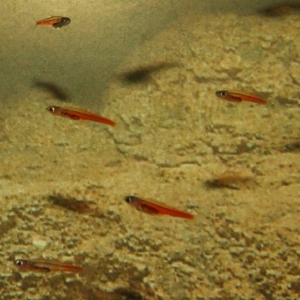Related Research Articles

Sundadanio is a genus of cyprinid fishes from freshwater habitats, typically peat swamps and blackwater streams, in Borneo and Sumatra in southeast Asia. At up to 2.3 cm (0.91 in) in standard length they are very small, but still larger than their close relatives Paedocypris. Species of the two genera are often found together.

Paedocypris is a genus of tiny cyprinid fish found in swamps and streams on the Southeast Asian islands of Borneo, Sumatra and Bintan.

Paedocypris progenetica is a tiny species of cyprinid fish endemic to the Indonesian islands of Sumatra and Bintan where it is found in peat swamps and blackwater streams.

The Borneo peat swamp forests ecoregion, within the tropical and subtropical moist broadleaf forests biome, are on the island of Borneo, which is divided between Brunei, Indonesia and Malaysia.

Hemirhamphodon is a genus of viviparous halfbeak fish. Most recognized species are endemic to lowland forest streams, rivers and swamps in Borneo, but H. phaiosoma and H. pogonognathus are also found elsewhere in Southeast Asia. The largest species reaches about 10 cm (4 in) in length. These fish are viviparous and are sometimes kept as aquarium fish, but otherwise have no commercial value.

Storm's stork is a medium-sized stork species that occurs primarily in lowland tropical forests of Indonesia, Malaysia and southern Thailand. It is considered to be the rarest of all storks, and is estimated to number less than 500 wild individuals throughout its geographic range. The population has long been in decline and the primary cause is widely considered to be deforestation of its native habitat.
Leiocassis is a genus of bagrid catfishes found mostly in Southeast Asia with some species occurring in China.

Parosphromenus is a genus of gouramies native to freshwater in Southeast Asia. All species are highly specialized peat swamp inhabitants native to southeast Asia, and the males are usually brightly colored in breeding dress; however, their need for soft, acidic water and live food prohibits the genus from becoming popular aquarium fish.
Maurice Kottelat is a Swiss ichthyologist specializing in Eurasian freshwater fishes.

Betta, is a large genus of small, often colorful, freshwater ray-finned fishes, known as "bettas", in the gourami family (Osphronemidae). The best known Betta species is B. splendens, commonly known as the Siamese fighting fish.

Betta albimarginata is a species of betta fish, endemic to the island of Borneo where it is only found in the Indonesian province of Kalimantan Timur. It inhabits the shallows of forest streams amongst vegetation and debris along the shores. This species grows to a length of 2.8 cm (1.1 in). It is a mouthbrooding species.
Paedocypris micromegethes is a species of cyprinid fish endemic to Sarawak in East Malaysia, where it is found in peat swamps. It is one of the smallest vertebrates in the world, with females reaching a maximum size of 11.6 mm.

The Lake Sentarum National Park is a national park protecting one of the world's most biodiverse lake systems, located in the heart of Borneo Island, Kapuas Hulu Regency, West Kalimantan Province, Indonesia. It lies in the upper Kapuas River tectonic basin some 700 kilometres upstream from the delta. The basin is a vast floodplain, consisting of about 20 seasonal lakes, freshwater swamp forest and peat swamp forest. Local people call it as Lebak lebung (floodplain). The National Park is located in the western part of this basin, where three-quarters of the seasonal lakes occur. Approximately half of the park consists of lakes, while the other half consists of freshwater swamp forest.

Deforestation in Borneo has taken place on an industrial scale since the 1960s. Borneo, the third largest island in the world, divided between Indonesia, Malaysia and Brunei, was once covered by dense tropical and subtropical rainforests.
Fangfangia spinicleithralis is a species of cyprinid fish endemic to Indonesia where it is found in the peat swamp forests of Kalimantan Tengah, Borneo. It is the only member of its genus. The genus name Fangfangia honors the Chinese-Swedish ichthyologist Fang Fang Kullander (1962-2010), who specialized in the study of cyprinid fishes.
Tyson Royal Roberts is an American ichthyologist. He has been described as "the world's foremost authority on Regalecus".
Heok Hee Ng is a Singaporean ichthyologist and researcher of biodiversity at the Lee Kong Chian Natural History Museum of the National University of Singapore. He specialises in Asian catfish systematics with particular focus on sisoroid catfishes. As of 2018, Ng authored 14 species of Siluriformes
Betta cracens is a species of gourami endemic to the island of Sumatra in Indonesia. It is an inhabitant of freshwater swamp forest. This species grows to a length of 5.7 cm (2.2 in), typically inhabits blackwaters that have very soft and very acidic water and is a bubble nest brooder. The Latin term cracens means "slender" or "elegant" and is so named because of the fish's slender body. It was first described in 1996 by Heok Hui Tan and Peter K. L. Ng in The Raffles Bulletin of Zoology.

The Southwest Borneo freshwater swamp forests ecoregion covers a number disconnected patches of freshwater swamp forest along the southwestern coasts of Borneo. The swamps are generally set back a few kilometers or two from the sea by the saltwater-affected Sunda Shelf mangroves The relatively fertile, flat soil has led to much of this ecoregion being converted to agriculture.

Risiophlebia is a genus of dragonfly in the family Libellulidae. It contains three species, all of which are endemic to the Central Highlands of the Mondulkiri Province and some other regions of southern Vietnam.
References
- ↑ "Profile of Heok Hui Tan on ResearchGate". researchgate.net. Retrieved August 25, 2018.
- ↑ "Heok Hui Tan on THE DIGITAL NATURE ARCHIVE OF SINGAPORE". lkcnhm.nus.edu.sg. Retrieved August 26, 2018.
- ↑ "Tan Heok Hui taxa on WikiSpecies". species.wikimedia.org. Retrieved August 26, 2018.
- ↑ "Google Scholar Citations" . Retrieved August 25, 2018.